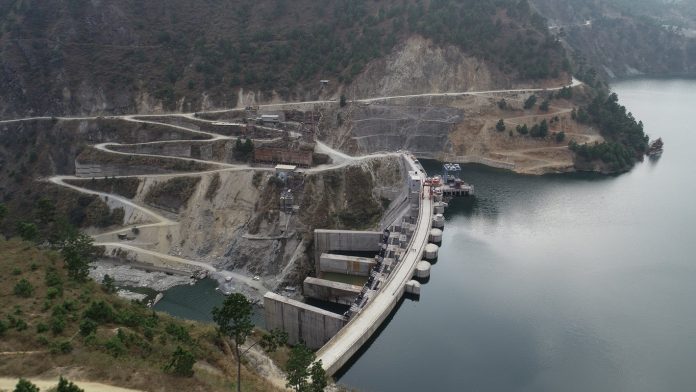The Story So Far:
Prime Minister Narendra Modi dedicated the 600 MW Kameng Hydro Power Station (HPS) to the nation on 19 November.
The project developed by the state-owned North Eastern Electric Power Corporation (NEEPCO) lies in the state of Arunachal Pradesh.
Swarajya explains the importance of this project for Arunachal Pradesh and the hydropower sector in India.
Where Is This Project Located?
The 600 MW Kameng HPS stretches over more than 80 km in West Kameng district of Arunachal Pradesh and is 90 km from Tezpur in Assam.
It is a run-of-the-river scheme which will utilize the flows from Bichom and Tenga Rivers (both tributaries of the River Kameng).
The project has two dams, viz. Bichom & Tenga and a powerhouse having four units of 150 MW each to generate 3,353 million units of electricity annually.
Water from the two dams is transported through a Head Race Tunnel into the powerhouse located at Kimi in West Kameng, for driving the 150 MW vertical turbine in each of the four units.
When Was The Project Approved?
The Cabinet Committee on Economic Affairs (CCEA) cleared the Kameng project on 02 December 2004 with an anticipated expenditure of Rs 2,497 crore and completion time of five years.
However, owing to a plethora of impediments like flash floods, major changes in primary design, law and order problems, etc, the project completion got delayed by over a decade.
All four units of the project were successfully commissioned progressively during June 2020 to February 2021, despite various hurdles faced during the COVID-19 pandemic period.
While unit 1 and 2 were commissioned in 2020, unit 3 and 4 were commissioned in January 2021.
The project cost shot up to Rs 8,450 crore due to delay in commissioning, a whopping 238 per cent cost over-run.
What Is The Significance Of The Project For India’s Hydropower?
As on 31 October 2022, the total installed capacity in the country is 408.71 GW which includes 46.85 GW of hydropower.
The country is endowed with huge hydropower potential, however, only a fraction of it is being utilized at present.
Only about 10 GW of hydropower has been added in the last 10 years.
The hydropower sector is currently going through a challenging phase and the share of hydropower in the total capacity has declined from 50.36 per cent in the 1960s to around 13 per cent in 2018-19, and 11.5 per cent in 2022-23.
The commissioning of Kameng HPS will form part of the projected hydro capacity addition of 30 GW by 2030 and improve the share of hydropower in India’s energy mix.
What Are The Key Benefits Of The Project For Arunachal Pradesh?
After the successful commissioning of the project, Arunachal Pradesh will receive a share of 83 MW power.
Further, the commissioning makes Arunachal Pradesh a power surplus state with huge benefits to the National Grid in terms of grid stability.
Arunachal Pradesh is likely to have a power surplus both in terms of peak demand and energy requirement on annual basis for the year 2022-23, according to a Load Generation Balance Report (LGBR) by the Central Electricity Authority (CEA), under the Union Ministry of Power.
According to the report, the state is expected to have an annual demand of 851 million units and the availability will be 1,373 million units, resulting in a surplus of 521 million units.
Apart from revenue generation, this project will provide employment opportunities to the educated youth of the state and promote industrialization in the region.
What Are The Other Ongoing Hydroelectric Projects In The State?
The state of Arunachal Pradesh is well endowed with hydropower potential, with a capacity of 50,064 MW (schemes with capacity above 25 MW).
Arunachal, thus, possesses 40 per cent of the country’s hydropower potential, and is considered as a “power house of India.”
Against this huge potential, the actual utilization is less than 800 MW.
The central and state government have planned a number of projects to increase the hydro generation potential of the state.
Some of the major projects include:
1. Subansiri Lower Project
- It is the biggest hydroelectric project undertaken in India so far and is a run-of-river scheme on River Subansiri.
- Located near North Lakhimpur on the border of Arunachal Pradesh and Assam, the 2,000 MW (8×250 MW) plant is likely to be completed in August 2023.
- The project has been marred by controversy from the beginning due to apprehensions of adverse impact on environment, livelihoods and flood-management, especially in Assam’s Dhemaji and North Lakhimpur districts downstream of the dam.
2. Dibang Hydropower Project
- It is a hydropower-cum-flood moderation scheme proposed on Dibang River in Lower Dibang Valley district of Arunachal Pradesh.
- The 2,880 MW (12×240 MW) power project has received forest and environment clearances and is expected to kick-off in the next year


